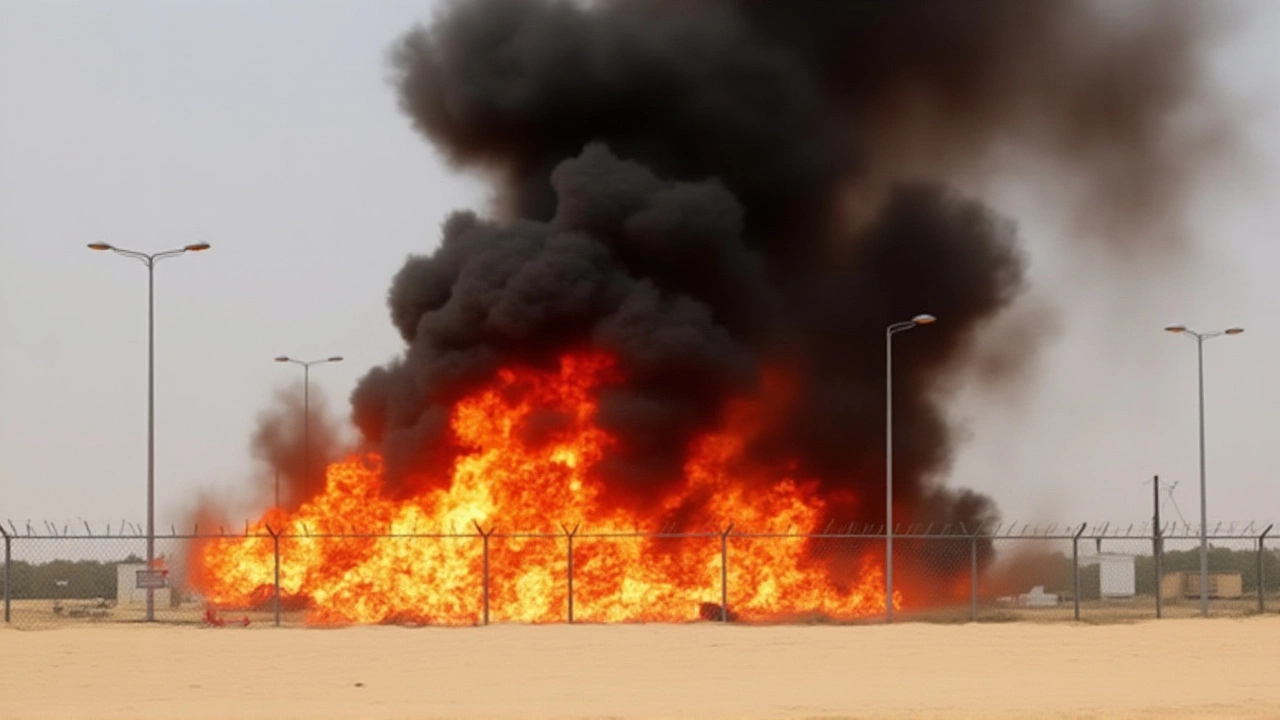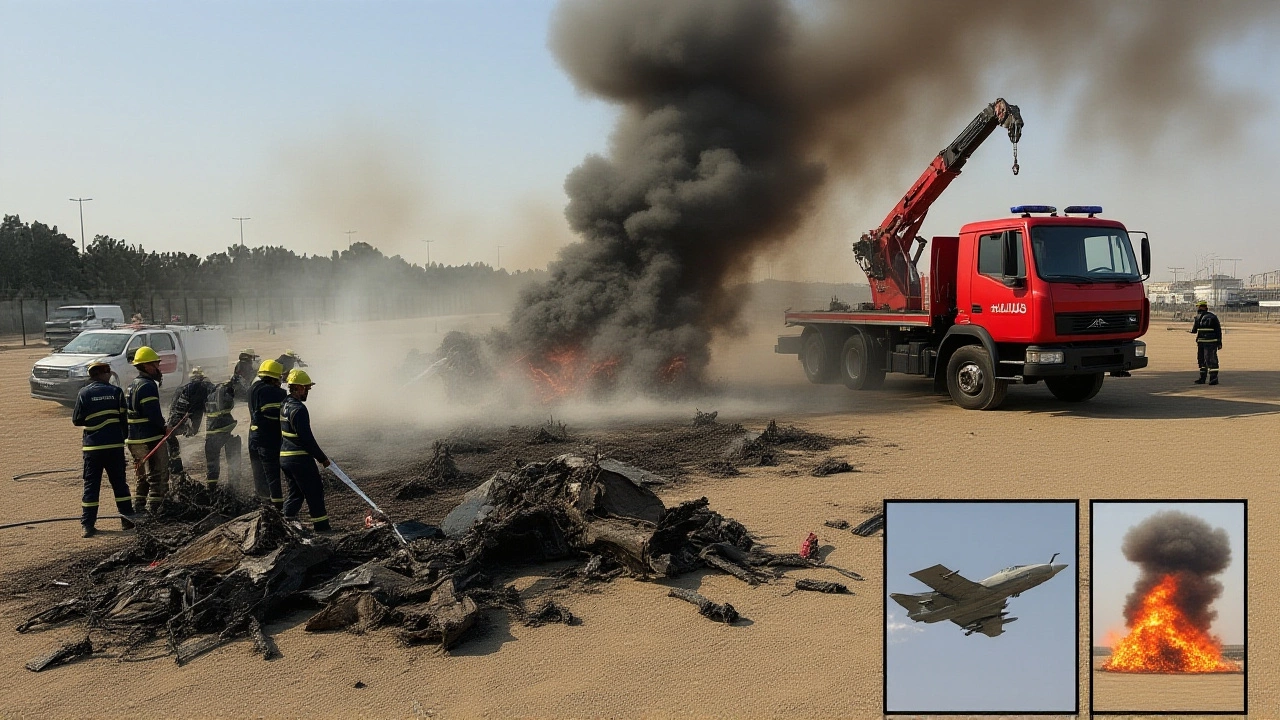At 2:12 PM local time on November 21, 2025, the sky over Al Maktoum International Airport in Dubai turned black with smoke as a Hindustan Aeronautics Ltd Tejas fighter jet plummeted from just 300 feet, exploding on impact. The pilot, Wing Commander Namansh Syal, a decorated veteran of the Indian Air Force, didn’t survive. It was the first fatal crash in the 23-year history of India’s homegrown fighter jet program — a moment that silenced the roar of the Dubai Air Show 2025Dubai and shattered confidence in a project once hailed as India’s aerospace triumph.
The Final Maneuver
Wing Commander Syal was performing the final aerobatic pass of the day — a high-stakes, low-altitude negative-G roll meant to showcase the Tejas’s agility. Witnesses described how the jet, painted in the Suryakiran Aerobatic Team’s crimson and gold, banked sharply, then suddenly went limp. No warning. No smoke. Just a violent pitch-down, like a bird struck mid-flight. The aircraft hit the tarmac at 2:12:03 PM, triggering a fireball visible from the VIP viewing stands. Emergency crews arrived within 90 seconds, but the heat was too intense. By 2:17 PM, the cockpit was unrecognizable.
The Dubai Air Show, which drew 1,500 exhibitors and over 180 aircraft from 140 countries, immediately suspended all flight demonstrations. Spectators were evacuated. By 4:30 PM, the Indian Air Force confirmed Syal’s death on X (formerly Twitter), announcing the formation of a Court of Inquiry. The UAE’s aviation authorities, known for their precision, opened their investigation logs to Indian teams within hours.
A Program Built on Patience — and Pain
The Tejas wasn’t supposed to be this hard. Development began in 1983, when India’s military still relied on MiG-21s from the Soviet Union. Over four decades, the project faced delays, budget overruns, and technical setbacks — 17 different design iterations, three prototype crashes, and years of public skepticism. But by 2024, it had achieved full operational clearance. The Indian Air Force had taken delivery of 42 Tejas Mk-1 jets, with 80 more Mk-1A and Mk-2 variants on order.
The jet’s engine — a General Electric F404 — was considered one of its most reliable components. The airframe, built at HAL’s sprawling Bangalore facility, incorporated Indian-made avionics, radar, and weapons integration. It was a symbol of self-reliance. And now, in front of the world’s defense buyers, it had failed.
Who Was Wing Commander Namansh Syal?
Wing Commander Syal, 38, was among the IAF’s most experienced display pilots. A graduate of the National Defence Academy, he had flown over 1,800 hours, including combat sorties during the 2019 Balakot airstrikes. Colleagues called him "calm under pressure." His final routine at Dubai was meticulously rehearsed — he’d flown the same sequence at Aero India 2023 and the Singapore Air Show in 2024. His wife, Anjali Syal, was in the audience. She didn’t leave her seat until the evacuation order came.
"He didn’t fly for applause," said his commanding officer in a private message to the IAF. "He flew to prove we could do it ourselves."

Industry Reaction and Market Fallout
On November 24, Hindustan Aeronautics Ltd released a statement calling the crash an "isolated incident caused by extraordinary circumstances." No technical details were shared. But the damage was done. Defense analysts noted that potential buyers — from Egypt, Argentina, and Vietnam — had been eyeing the Tejas as a cost-effective alternative to the F-16 and Rafale. Now, questions mounted: Was this a one-off pilot error? A software glitch? A structural flaw?
Shares of HAL, which had dipped 3% on the day of the crash, stabilized by the afternoon. The company insisted operations and delivery schedules were unaffected. But export contracts? Those are harder to quantify. One unnamed European defense official told Dawn.com: "We’re watching. But trust isn’t rebuilt with press releases."
What Happens Now?
The Court of Inquiry, led by Air Marshal R.K. Mehta, has 30 days to deliver preliminary findings. Standard procedure requires examining flight data recorders, maintenance logs, pilot health records, and even weather conditions. The UAE’s Civil Aviation Authority is providing radar and video data. A team of GE engineers has arrived in Bangalore to assist.
Defense Minister Rajnath Singh, speaking in Parliament on November 25, called Syal "a martyr of India’s aerospace dream" and reaffirmed the government’s commitment to the Tejas program. But whispers are growing. Some IAF officers privately question whether the pressure to showcase the jet overseas compromised safety protocols. Others point out that no Tejas has ever performed a negative-G roll at under 500 feet during a public display before.

Why This Matters Beyond India
The Tejas wasn’t just India’s project. It was a test case for emerging economies trying to break into advanced defense manufacturing. If a nation with India’s resources and talent can’t deliver a safe, reliable fighter jet after 40 years, what hope is there for others? Countries like South Korea, Brazil, and Turkey are watching closely. The crash could slow global interest in domestic defense programs — or, paradoxically, accelerate them, as nations vow not to repeat India’s long, painful journey.
Meanwhile, at Al Maktoum Airport, the burn marks on the tarmac are still visible. A small memorial — a single helmet, a pair of flight boots, and a folded Indian flag — sits near the crash site. No official plaque yet. But those who were there say it won’t be forgotten.
Frequently Asked Questions
Was this the first Tejas crash ever?
No. The Tejas program had experienced one previous non-fatal accident in 2014 during a test flight near Bangalore, where the aircraft skidded off the runway after a landing gear malfunction. That incident led to minor redesigns in the landing system. The Dubai crash is the second accident in 23 years — and the first to result in a fatality since the jet entered operational service in 2016.
How many Tejas jets have been delivered so far?
As of 2025, the Indian Air Force has received 42 Tejas Mk-1 aircraft, with another 83 Mk-1A variants on order. Production is ramping up at HAL’s facility in Bangalore, with plans to deliver 16 jets annually through 2030. The Mk-2 variant, with a more powerful engine and improved radar, is expected to enter service by 2028.
Could pilot error have caused the crash?
It’s possible, but unlikely to be the sole cause. Wing Commander Syal was a highly experienced display pilot with over 1,800 flight hours and a flawless safety record. The Tejas is designed to handle negative-G maneuvers — but only above 1,000 feet. Performing one below 500 feet, as reported, pushes the aircraft beyond its safe envelope. Investigators are examining whether the flight control software misinterpreted inputs or if a sensor failure occurred during high-G stress.
What role did General Electric play in this?
General Electric supplied the F404 engine, which has a 99.7% reliability rate across global fleets. GE has no control over the flight control software or airframe design — those are HAL and IAF responsibilities. However, GE engineers are assisting the inquiry to rule out any engine-related anomalies, such as compressor stalls or fuel flow disruptions under extreme maneuvering conditions.
Will this hurt India’s defense exports?
Yes, in the short term. The Tejas was being pitched to over a dozen countries as a low-cost, high-tech alternative to Western fighters. The Dubai crash, captured on viral video, has raised doubts. While India has already secured a $1.2 billion deal with Argentina for 24 Tejas Mk-1A jets, potential buyers like Egypt and Vietnam have reportedly paused decisions. Long-term, if the inquiry clears the design, exports may recover — but trust takes longer to rebuild than it does to break.
What’s next for the Tejas program?
HAL has confirmed all flight demonstrations are suspended until the inquiry concludes. The Mk-2 variant’s first flight, scheduled for early 2026, remains on track — but may be delayed if new safety protocols are mandated. The Indian Air Force is also reviewing its aerobatic display guidelines, especially for low-altitude maneuvers. Meanwhile, defense analysts say India may accelerate its next-gen AMCA (Advanced Medium Combat Aircraft) program to reduce reliance on the Tejas for international prestige.

